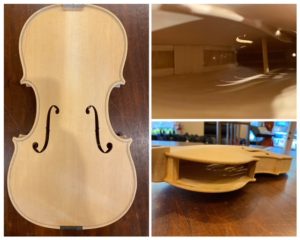Violins are the most efficient acoustic amplifiers in the world. They reflect and amplify the energy imparted to the strings without the use of electricity. The quality of a violin can be measured, in part, by its ability to project sound to the far reaches of a concert hall.
To understand why some instruments are louder than others we must examine how and why violins work. When violin strings vibrate they make the bridge and top plate vibrate. The soundpost transfers the energy to the back and sets it into motion. The ribs (stuck between the top plate and back) also vibrate. All of this movement causes the air inside the instrument to project sound waves out through the f-holes and towards the audience.
Instruments that are constructed in a way that reduces resistance will transfer the energy efficiently and are loud. There are many factors that influence vibration transmission in a violin. Some of the major factors include how much Inherent Tension was introduced when the instrument was made, how well the Setup fits the instrument and the type of Varnish used to cover the body.

Violin before varnish with the rib removed to show the internal structure
Inherent Tension: The violin is made of many pieces that are carved from solid blocks of wood. The top and backs are arched by carving away wood to the desired shape. The ribs are thin pieces of wood (~1mm thick) that are bent over heat to conform to the outline of the instrument. They are glued to blocks of wood located at the top, bottom and each corner of the instrument. All the pieces are held together with hide glue. If all the pieces are carved precisely they will fit together easily, without tension. The absence of tension allows for quick response and articulation. It facilitates a free, open, ringing tone that lasts long after your bow has left the string.
Setup: The setup is the lens through which you see the violin. A good setup allows a clear picture, providing the acoustic qualities of the violin to shine. The goal of a setup is to encourage the instrument to vibrate as much as possible. A good setup does not increase the instrument’s capacity for volume, it simply allows the violin to vibrate and ring without impedance.
Varnish: Varnish serves a dual purpose of protecting the wood and focusing vibrations. In addition to being beautiful, varnish must be paradoxically hard enough to keep the wood safe from impact and soft enough to flex and vibrate with the instrument. Varnish that is too soft fails to protect the instrument and fails to focus the body’s vibrations causing a loss of projection. Varnish that is too hard resists vibrations and limits volume. Good varnish protects the wood, focuses vibrations and helps maximize volume.

